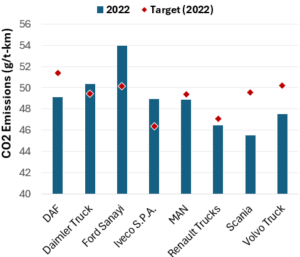Regulations
US EPA MY 2027-2032 Heavy-Duty Phase 3 GHG Standards Announced
A preview to a longer summary to come on the final EPA rule on CO2 emission limits for heavy-duty vehicles
Reference
Greenhouse Gas Emissions Standards for Heavy-Duty Vehicles – Phase 3
Published March 29, 2024
Towards the end of March, 2024, the US EPA has published the final rule limiting CO2 emissions from model year (MY) 2027 – 2032 heavy-duty vehicles, such as vocational and long-haul trucks and buses. This is a brief note, if you are interested in an updated longer version, sign up to the “5-min Monthly” below.
As context, the proposal for this rule was published a year ago and we have covered that here.
After a year of consideration of stakeholder comments, the EPA has published the final rule. The plot below shows, as example, the CO2 reductions required of Class 8 Day cab and Sleeper cab trucks.

Some Implications
As is evident for this case of long-haul trucks, the CO2 reductions required are significantly steeper than in the previous rule, and is unlikely to be met through incremental technologies alone.
Note that the rule is technology neutral: that is, any combination of technologies and powertrains can be used to meet the requirements. The EPA has analyzed advanced internal combustion engines (ICEs), transmissions and trailers (think SuperTruck 2), hybridization, compressed natural gas, and relatively new powertrains such as hydrogen combustion, fuel cell and battery electric vehicles (BEVs), as potential pathways.
Nevertheless, the assumption in determining the viability of the rule is that ICE technology remains at the MY2027 level, while other powertrains, notably BEVs gain share due to their favorable total cost of ownership. In that scenario, the above plot, for instance translates into a predicted ~ 25% and 40% share of new vehicles sold to be zero tailpipe emitting for sleepers and day cabs, respectively, by 2032.
The industry has always risen up to meeting tough EPA standards in the past, and “this time is different” has also been said before, but perhaps this time it truly is different, since success depends not only on technology improvements but also on development of completely new fueling infrastructure (charging and hydrogen), and for the economics to work out for fleet owners to adopt new powertrains.
Also, note that the trucking industry has to meet not just this GHG rule but also reduce NOx emissions by ~ 80% over the same timeframe, through a separate “Cleaner Trucks Plan” which we have summarized earlier. Balancing the requirements for reducing both NOx and CO2 emissions is not trivial.
More to come, sign up for a detailed version.
Closing Remarks
The industry has always risen up to meeting tough EPA standards in the past, and “this time is different” has also been said before, but perhaps this time it truly is different, since success depends not only on technology improvements but also on development of completely new fueling infrastructure (charging and hydrogen), and for the economics to work out for fleet owners to adopt new powertrains.
Also, note that the trucking industry has to meet not just this GHG rule but also reduce NOx emissions by ~ 80% over the same timeframe, through a separate “Cleaner Trucks Plan” which we have summarized earlier. Balancing the requirements for reducing both NOx and CO2 emissions is not trivial.
More to come, sign up for a detailed version.
Sign up here to receive such summaries and a monthly newsletter highlighting the latest developments in transport decarbonization
5-Min Monthly
Sign-up to receive newsletter via email
Thank you!
You have successfully joined our subscriber list.
Recent Posts

Conference Summary – SAE WCX 2025
![]()
A summary of the “SAE WCX 2025” conference held in Detroit.

IRENA Renewable Energy Capacity Statistics 2025
![]()
According to the latest report from IRENA, 2024 saw the largest increase in renewable capacity, accounting for 92.5% of overall power additions.

CO2 Emissions Performance of Heavy-Duty Vehicles in Europe – 2022 Results
![]()
The European Commission has published the official 2022 CO2 emission results for heavy-duty vehicles. Many OEMs are ahead of the targets and have gained credits, while others have their work cut out as we approach the 2025 target.

